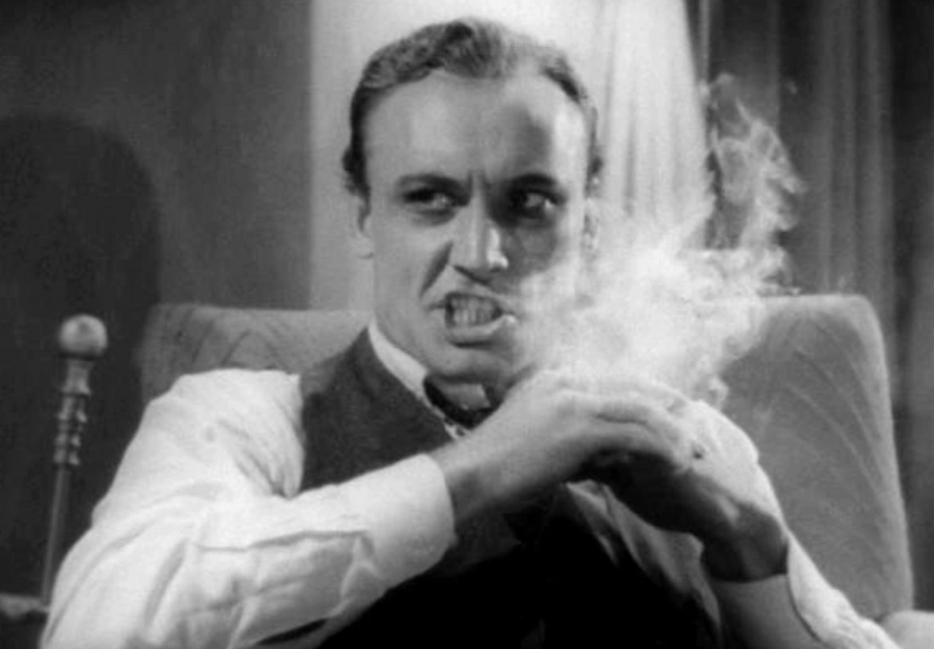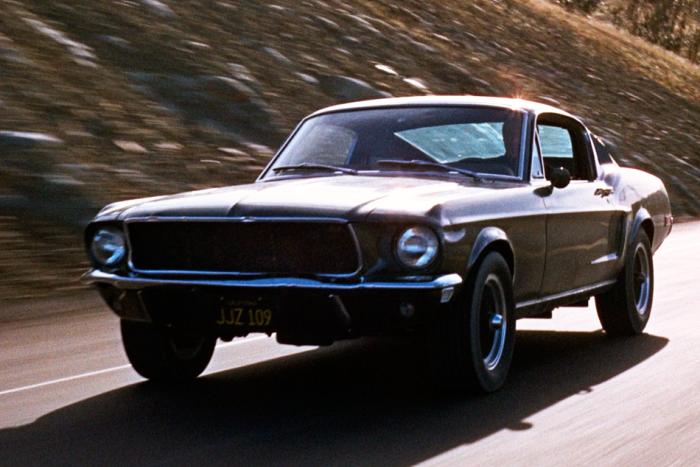“The first effect is sudden, violent, uncontrollable laughter; then come dangerous hallucinations—space expands—time slows down, almost stands still….fixed ideas come next, conjuring up monstrous extravagances—followed by emotional disturbances, the total inability to direct thoughts, the loss of all power to resist physical emotions…leading finally to acts of shocking violence…ending often in incurable insanity.”
In 1972, Keith Stroup, founder of the National Organization for Reform of Marijuana Laws (NORML), discovered a decrepit print of Reefer Madness, a 1936 clarion call about the dangers of cannabis, in the Library of Congress archives. The film, which begins with a promise that what proceeds is “based upon actual research into the results of Marihuana addiction,” tells the story of a group of white, middle-class high school friends whose lives are thrown into chaos by the drug. Their “habit” results in a hit and run, an attempted rape, manslaughter, and suicide, but the most memorably wrong impression to gather from the film is that cannabis (or “marihuana”) turns its users into hysterical monsters driven by their basest desires. Realizing the film was in the Public Domain, Stroup bought a print for $297 and screened it at college campuses in California to help finance a campaign to legalize marijuana in the state.
For its new audience—college students who were fairly well acquainted with the drug, or at least its effects—this sensationalized account of “Marihuana addiction” was a kick. If watched in earnest, the movie is pretty boring, full of static, unimaginative shots, stock music, and stilted acting, but throw in a quarter ounce and a group of friends, and watching it becomes an event. Upon realizing its ironic appeal, Robert Shaye of New Line Cinema (a very long way from financing The Lord of the Rings) obtained a copy and distributed it on the midnight circuit at repertory cinemas and college campuses across the country. Over the years it became a popular cult film, ready-made for “worst-ever” lists.
Since its revival in the ’70s, Reefer Madness has had a decided cultural impact. A colourized version, full of psychedelic greens and purple-tinted smoke, was released on DVD in 2004; meanwhile, the internet has made the film available instantly and for free. In 1998, a Los Angeles theatre troupe adapted it as a musical, which is still being staged. Seven years later, the musical became a film starring Kristin Bell and Alan Cumming, making Reefer Madness the stoned cousin of Hairspray and The Producers in the bland little family of screen-to-stage-and-screen-again properties. Cumming will be returning to the role in an Off-Broadway production this 4/20.
Modern audiences think of Reefer Madness as “Pure Camp”—that is, an unintentionally ridiculous bit of institutional propaganda, godparent of the after-school special. Combine this attitude with touch of chronological ethnocentrism (the belief that people of the present are smarter than people of the past) and the result is the misconception that Reefer Madness is representative of its time, and was instrumental in demonizing cannabis and its users.
The spread of misinformation about cannabis came from institutions far more prominent than the producers of Reefer Madness—like Henry Anslinger, czar of the Federal Bureau of Narcotics, who claimed that a bust of 60 joints in Detroit was “enough fodder for sixty murders.” Much of the rhetoric around cannabis use during the Great Depression was both hysterical and tinged with xenophobic fervour, but cannabis was not widely used among white, middle-class people at the time, and evidence suggests that Anslinger’s campaign to have the substance regulated was of little concern to the vast majority of Americans. On its release in 1936, as it circulated grimy “Main Street” cinemas throughout the United States, Reefer Madness was shown for salacious rather than educational purposes—audiences went to see it for the spectacle of drug use, something alien and exotic, something demonized by authorities and forbidden from mainstream cinema.
*
Not much information is available on the production of Reefer Madness. Most online accounts claim that it was produced by a church group, then purchased and re-edited with sensational additions by notorious exploitation film producer Dwain Esper. I cannot find any confirmation, however, that this version of events is true. What’s certain is that the original title of the film was not Reefer Madness but The Burning Question (it was also known at some point as Tell Your Children), and that it was not unique: contemporaneous films that took on the “evils” of cannabis include Marihuana (1934), and Assassin of Youth (1937), while cocaine and opiates were scapegoated for society’s ills in The Pace that Kills and Narcotic. These films were not nanny-state propaganda; in fact, films like these, which flouted Production Code-era standards of drug use depiction, were frequently cited as reasons for state censorship.
Reefer Madness and its ilk were the original exploitation films. “Exploitation” is now associated with the excessive, low-budget genres of the ’60s and ’70s (sexploitation, blaxploitation, etc.). But earlier in the century, during the reign of Production Code—the mainstream film industry’s attempt to uniformly self-censor, thereby appeasing regional censorship committees across the US—lurid content was shown under a different guise. Films like Reefer Madness were produced independently, away from the auspices of Hollywood studios. Working quickly with low budgets, producers could capitalize on controversial topics discussed in the media but barred from respectable screens, like nudism in Elysia, Valley of the Nude; miscegenation in Jungle Virgin (depictions of miscegenation were banned by the Code until 1953); and white slavery in Slaves in Bondage (depictions of white slavery were also banned by the Code). More frequently, the subjects were sex and drugs. Distributors of exploitation films could tailor their prints to the censors of each city or state they travelled through, often making both “cold” prints for prudish regions and “hot” prints for more liberal markets.
The most popular exploitation offerings were “sex hygiene” films such as Is Your Daughter Safe?, Unguarded Girls, and Human Wreckage. Their narratives were similar to those of the drug films: respectable young person of the middle class is tempted into premarital sex by someone of the “lower” classes, at which point he or she contracts syphilis or gonorrhea and brings it back home, perhaps spreading it to a spouse or, worse, an offspring. Usually, the story would stop in its tracks for a few moments to give the audience a peek at “real” syphilitic sores or a live childbirth. These films were almost always classist, positing drugs, venereal diseases, and vice as problems from a criminal “lower” class that threatened to corrupt the morally upstanding white, protestant mainstream.
The positioning of these films as “educational,” however disingenuous, served a few purposes. It made it easier for the films to pass state and municipal censorship laws (particularly the chaste “cold” prints), and preempted the threat of widespread censorship from the federal government (which, to date, has never been implemented in the United States for cinema). The MPPDA (the Motion Picture Producers and Distributors of America, who enforced the Code) was also hoping to avoid government interference in their industry; as a result, exploitation films became, like a fly on the ass of an elephant, a nuisance that simply wouldn’t go away.
*
In his book Bold! Shocking! Daring! True!: A History of Exploitation Films, 1919-1959, film scholar Eric Schaefer suggests that the modern corollary to these films is not the after-school special, but the trash talk show: both forms share an emphasis on “truth,” as well as a connection to current events, while being designed to titillate. Posters for the exploitation film Escort Girl promised “Secrets, Sex-posed, Sensationally!,” while Gambling with Souls guaranteed “a true exposé of the sensational events recently seen in the nation’s headlines.” Perhaps Reefer Madness was the Jerry Springer of its era.
The similarities extend to how these films were exhibited. Since most first-run theatres were owned by mainstream studios, exploitation distributors, often consummate showmen, would rent out “Main Street” theatres—independent houses that often operated on the edges of slums—and transform their lobbies into carnivalesque displays, replete with decorations and props, with booklets and stills available for purchase (particularly popular for nudist and burlesque films). For the sex hygiene films, pamphlets on sexual health, often hopelessly outdated, would be sold by young women in nurse outfits. And then there were “guest lecturers,” actors pretending to be experts on drug use or venereal disease. For the release of Mom and Dad (1946), a cautionary tale about premarital sex that became the most popular exploitation film of its time, showman producer Kroger Babb promised lectures from “Elliot Forbes,” a “Fearless Hygiene Commentator,” at every screening of the film—even simultaneous screenings. He’d hired different actors to portray the same man at every theatre.
Widespread box office returns from exploitation films are impossible to find, but a few case examples show they could be quite profitable on a theatre-by-theatre basis, sometimes performing at the same level as second-run studio pictures that played on the same screens. Produced on shoe-string budgets, the films were often padded out to feature length with inane and sometimes nonsensical narrative developments, all in the service of a few short moments of taboo footage (usually a far cry from what was advertised). But they provided entertainment, and explored, if misrepresented, topics that had been banned from polite conversation.
It’s debatable whether or not audiences viewed Reefer Madness with a sense of irony in 1936. There’s little to suggest producers were aiming for comedic effect, but the evidence for pedagogical intent is equally low. Perhaps trash television can shine a light on how these films were seen by their original viewers. Jerry Springer’s audience is probably neither completely naïve nor ironically detached, but most likely something in between—viewers know the score but choose to buy in. These shows don’t appeal for their informative value, but because they promise a freak show. And while they don’t necessarily wink at the audience, they push spectators toward a sense of disbelief: the less believable the story, the better. Similarly, exploitation cinema exaggerated the dangers of drug use and premarital sex in order to bring in audiences hoping to witness the dangers of drug use and premarital sex.
Something to bear in mind if you spend this year’s 4/20 watching Reefer Madness: what you’re watching isn’t quite anti-drug propaganda. Audiences in the 1930s weren’t as naïve as we perceive them to be; maybe, if they were around today, they’d be watching My Strange Addiction and laughing with the rest of us.






